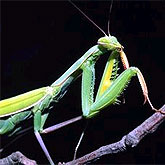The Art of Hunting
 Most of us have seen a praying mantis. Two thousand species of praying mantis are scattered throughout the world, ranging in size from less than half an inch (1.27 cm) to more than five inches (12.7 cm). In tropical regions, up to 350 species can inhabit an area. Although most of us place praying mantises in a class of their own, entomologists have classified them in the order Orthoptera that includes six families – including cockroaches and walking sticks.
Most of us have seen a praying mantis. Two thousand species of praying mantis are scattered throughout the world, ranging in size from less than half an inch (1.27 cm) to more than five inches (12.7 cm). In tropical regions, up to 350 species can inhabit an area. Although most of us place praying mantises in a class of their own, entomologists have classified them in the order Orthoptera that includes six families – including cockroaches and walking sticks.
In the United States, all species of the praying mantis are known as the gardener's friend because of their appetite for other insects. One of the most common in this country is the Chinese praying mantis, which was imported in 1896 for general release, an attempt by entomologists to augment the insect control services rendered by the smaller native species of North America. The praying mantis is also prey for other animals, especially bats. But even for bats, the praying mantis is no easy meal. A unique auditory system often helps the praying mantis escape these skilled night predators. Interestingly, for years the praying mantis was thought to be deaf because entomologists could not find its ears, although they had found ears on its relatives the crickets and grasshoppers. They were looking in the wrong place.
Mantises have a single ear slit, about a millimeter in length, and two teardrop-shaped eardrums, which face each other from opposite walls inside the slit and function as a unit. This single ear gives the praying mantis hearing in the ultrasonic range between 25 and 100 kilohertz. Although a single ear can't locate the source of the sound (an ability that requires two ears, separated), nondirectional hearing in this range is particularly useful to the mantis when bats, using sonar to navigate, are in the area.
About the Author
Joanne Lauck, MS
 As an environmental educator, professional writer, former counselor, and certified wildlife rehabilitator, Joanne Lauck brings an eclectic group of skills to her work. She received her Bachelor of Science degree in psychology and a Masters of Science degree in experimental psychology. Joanne also is a graphic artist and currently teaches graphic art at the high school level in San Jose, California.
As an environmental educator, professional writer, former counselor, and certified wildlife rehabilitator, Joanne Lauck brings an eclectic group of skills to her work. She received her Bachelor of Science degree in psychology and a Masters of Science degree in experimental psychology. Joanne also is a graphic artist and currently teaches graphic art at the high school level in San Jose, California.


